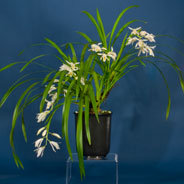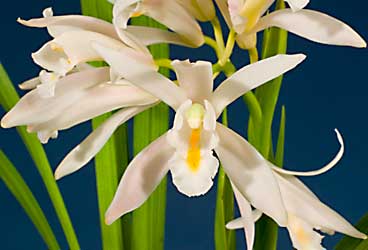

by Marni Turkel / Originally Published in Orchids Magazine
| Hybrid Flask List |
| Orchid Programs |
 There is a certain uniformity in modern, commercial Cymbidium hybrids which does not hint at the diversity of the genus. Most people don’t realize that the genus Cymbidium includes everything from single-flowered terrestrial species native to temperate climates to robust epiphytic warm-growing tropical species. Cymbidium species are found throughout Asia from south India and Sri Lanka as far east as the Philippines and Australia. The genus on the species level is well worth investigating. It is the beauty of species cymbidiums that has made them a classic subject in East Asia art for thousands of years.
There is a certain uniformity in modern, commercial Cymbidium hybrids which does not hint at the diversity of the genus. Most people don’t realize that the genus Cymbidium includes everything from single-flowered terrestrial species native to temperate climates to robust epiphytic warm-growing tropical species. Cymbidium species are found throughout Asia from south India and Sri Lanka as far east as the Philippines and Australia. The genus on the species level is well worth investigating. It is the beauty of species cymbidiums that has made them a classic subject in East Asia art for thousands of years.
Gracefully arching spikes of almond-scented flowers combined with an interesting growth habit make the rarely seen Cymbidium mastersii a wonderful addition to an orchid collection. Unique among the genus, the individual growths of this species continue to slowly elongate and produce new leaves and inflorescences over many years. Unlike the typical large egg-shaped pseudobulb seen in common Cymbidium hybrids, the pseudobulb of Cym mastersii is stem-like; the active top portion carries 6 to 17 leaves which are up to 25” long while the lower part is enclosed in tightly imbricating (interlocking) old leaf bases. Because this species only infrequently produces a new pseudobulb from the base, the plants remain a manageable size for many years. The 2.5” wide flowers, which remain cupped, are white or white with a pale pink blush, the base of the lip and callus yellow. In addition, the lip sometimes has purple-red spots. The 5 to 15 flowers are presented on a raceme that is up to 12” long and emerges from the axils of the upper leaves.
First described in 1845 from a plant blooming in the collection of the Loddiges nursery in England, it was named for John William Masters  (1792-1873) who worked at the Botanical Garden in Calcutta. Until recently, the known distribution of Cym mastersii was northern India, Myanmar (Burma), and northern Thailand. In 1993 it was also recorded from Yunnan Province in China. It is found from 2950-7200 ft (900-2200 m) where it grows on trees and rocks in evergreen forest, often in deep shade.
(1792-1873) who worked at the Botanical Garden in Calcutta. Until recently, the known distribution of Cym mastersii was northern India, Myanmar (Burma), and northern Thailand. In 1993 it was also recorded from Yunnan Province in China. It is found from 2950-7200 ft (900-2200 m) where it grows on trees and rocks in evergreen forest, often in deep shade.
From reading the available literature on the habitat, one might assume that Cym. mastersii should be grown in relatively low light, but I have found the opposite to be the case. I grow it in fairly bright light where a hand held 18” over the plant casts a distinct shadow. This is enough light to bloom hybrid cymbidiums, sobralias and Mexican laelias adjacent to this plant. The temperature range in this part of the greenhouse is normally between 50 F and 80 F. In extreme cases, it has gone as low as 32 F and as high as 102 F for brief periods without any signs of ill effect. Cymbidium mastersii should grow well in any mix suited for other cymbidiums. I grow it in a terrestrial mix that is made up by volume of 3 parts washed and sifted 1/8” fir bark, 5 parts 1/4” perlite, 3.5 parts well washed powdered coir (coco peat), 1.5 parts 1/2” lava rock and 1 part 1/4” horticultural charcoal. These should be considered approximate amounts and the ingredients can be varied to suit individual needs and availability of ingredients. In the spring and summer I water this plant more frequently than most of my orchids, but I do not give it a particular dry rest in the winter, rather I keep it on the same watering schedule as the majority of the collection. It is fertilized with 1/2 strength liquid fertilizer every second watering for most of the year and approximately 1 out of 4 waterings in the fall and winter.
References
Baker, Charles and Margaret 1997. Orchid Species culture: Cymbidium mastersii. sheet version 566931 http://www.orchidculture.com.
Chen, S.-C., Z.-H. Tsi and Y.-B. Luo 1999. Native orchids of China in
Colour. Science Press, Beijing, China.
DuPuy, D. and P. Cribb 1988. The Genus Cymbidium. Timber Press, Portland,
OR.
Mostly Species / Orchids and Flasks | Santa Rosa, CA 95407
© Marni Turkel 2003-2022 All rights reserved